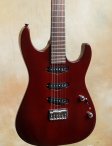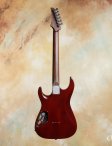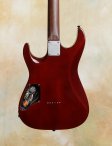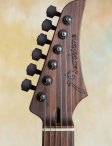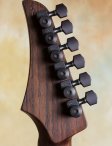Marchione VT Spruce/Rosewood, 2015

Price: $--SOLD
inquire - info@crguitars.com
call us -
2015 preowned, in like new condition
This spruce top Marchione was originally sold by CR Guitars in 2015 and is now available again for purchase. This is a great chance to obtain a rare and beautiful Marchione that is in like new condition at a great price. This spruce body / rosewood neck guitar is yet another marvel from Stephen’s bench. Weighing an astonishing 6 pounds, and NOT chambered, the guitar feels incredible in your hands.
This spruce top Marchione was originally sold by CR Guitars in 2015 and is now available again for purchase. This is a great chance to obtain a rare and beautiful Marchione that is in like new condition at a great price. Below is my original writeup for this guitar.
THE STORY
For some reason in the guitar industry, bolt on neck guitars are thought of as being less of an art form than other guitars. No doubt the reason is that the original bolt on style guitars were production guitars made in the '50s. They were designed and built as utilitarian instruments for working guitarists. If you broke the neck on your guitar, for example, you could simply order a new neck, bolt it on and you’d be back playing music in no time.
But almost inadvertently, something amazing was created. With the right combination of elements, a bolt on neck guitar can be sublime, with balanced tones throughout the fretboard and a wonderfully articulate, present voice. Vintage guitars these days carry such incredible monetary value because of their history, but not all of them are great instruments (which is a secret the guitar industry tries to keep hidden). There are absolutely magical vintage instruments out there, to be sure, but fine guitars makers these days are leagues ahead of the production guitars made 40 - 50 years ago. And it takes every bit as much skill to build a fine bolt on neck guitar as any other instrument.
In my experience, one of the most important skills for a luthier is being able to pick the right wood for an instrument. Back on the line in the '50s and '60s there was very limited ability to select the right wood for a particular guitar, of course, but sometimes everything came together—the grain, the weight and balance of the woods—and a truly great guitar was made. Such guitars are the vintage instruments we all lust after, even though very few people can afford them these days. Whereas you can be assured of a great instrument by choosing a guitar made by one of the master luthiers working today.
As I have mentioned before, in the '80s I was seduced by a spruce body Pensa-Suhr guitar a fellow session player had had custom made, and over the years have thought a lot about the qualities of a solid spruce guitar. In the hands of the right luthier spruce can make a wonderfully open, resonant and responsive instrument. But it is also a wood that in the wrong hands can yield a faltering voice and a weak, even tin-like tone. I got it in my head that I wanted a guitar with a solid spruce body for the quick, open and resonant voice, and a rosewood neck for sustain and focus. But I knew I would have to chose the right luthier to make such a guitar because the two woods are so different, with different densities and weights and vibrational characteristics. It had to be a luther with consummate mastery of the entire range of guitar making skills, and especially wood selection.
The right luthier was Stephen Marchione.
Among his many remarkably developed talents, one of Stephen Marhione’s best is deeply knowing wood. It can seem shamanistic when a great luthier selects wood for a guitar, but it's not really mysterious at all. It comes from years and years of paying careful attention to every decision, every nuance and developing a knowledge about wood that transcends common understanding. Stephen can pick up a piece of wood, tap it, look at the grain, and know if it will make a great instrument, but he can do this only because he has devoted his life to the art of guitar making. When you play one of Stephen’s guitars, you are not just playing the guitar in front of you, but all of his years of development. Great guitars never exist in isolation, but are the product of the unceasing desire of a person to create something great.
THE GUITAR
This spruce body / rosewood neck guitar is yet another marvel from Stephen’s bench. Weighing an astonishing 6 pounds, and NOT chambered, the guitar feels incredible in your hands (and with a guitar strap around your neck there is very little pressure on your shoulders). Yet it speaks with a strong, clear and nuanced voice, and is immediately responsive to your every musical gesture. Super light solid body guitars can give up tonal depth, but with Stephen’s masterful wood selection this guitar only gains in articulation from the light, responsive Sitka spruce wood, and the instrument has ample sustain. The solid rosewood neck is balanced perfectly with the body as well.
In some ways Stephen’s guitars are like hot rods, sleek designs that grow from his examination of every detail and subtlety of the guitars that came before him. Marchione guitars are unique designs, but they are rooted in history. In this way they are like the most fanciful cars you will ever see, the Ferraris of the guitar world.
One of the hallmarks of Stephen’s work is clean lines and perfect joints, and this guitar is no different. Another is resonance. Part of the reason his instruments speak with such a clear, resonant voice is his mastery of wood selection, and another reason is his commitment to using hide glue, something very few electric guitar makers use. Using hide glue is more difficult and time consuming. You have to use a heated pot to keep the glue at a particular temperature, and it tends to be messy, so extra care must be taken in the gluing process. But hide glue, unlike the yellow glue most luthiers use these days, dries to a crystalline, hard structure that does not dampen the vibrations of the wood like other glues. Many more classical guitar makers and violin makers use hide glue because of the obsession classical guitarists and violinists have about tone, and in Stephen’s experience the extra work of using hide glue is well worth it for electric instruments as well.
It goes without saying that the finish is superb, as are all Marchione finishes. But special mention should be made of the neck, because it is notoriously difficult to finish rosewood. Stephen’s uses a hand rubbed oil finish that makes the neck feel like an extension of your hand, and the wood doesn’t grab at your skin in the least. Whether playing fleet fingered passages or simple chords that last whole measures or more, then neck just feels like home. Too, the neck and fingerboard were cut from the same plank of rosewood.
This guitar also has a new feature I have not seen before on Marchione guitars. The rear plate that covers the back of the electronic controls is clear, allowing you to see the stellar military spec wiring work. This reminds me of the way watchmakers use a clear back to show the interior workings of a watch, called an “exhibition case back,” and the concept works perfectly here. I love that Marchione is proud of his writing and wants to show it off!
If you'd like to find out more about this item, just call or e-mail me. It would be my pleasure to talk to you about it.
ABOUT MARCHIONE GUITARS
At one time in his life, Stephen Marchione spent six hours a day playing the guitar. Now he makes them—in fact, since beginning his career as a guitar maker in 1989, Stephen has created more than three-hundred guitars for some of the best guitar players in the world. The journey from high-school jazz devotee to “the finest young guitar maker working today,” according to Chamber Music America, was a rich and complicated one. After establishing his own brand and working for several years in New York, Stephen Marchione moved to Houston, Texas, where he builds his entire family of guitars, but Marchione has also studied privately since 1994 with Manhattan-based violin maker Guy Rabut. "I try to build one violin a year to keep my chops up" Says Marchione. He feels that building classical guitars and violins broadens his understanding of top thicknessing, tap tuning, and surface preparation. On the other hand, building electric guitars has taught him the importance of the fretboard in a player's appreciation of a guitar. Marchione is considered one of a very few leading-edge pioneers in the design of guitars that combine elements of both jazz and classical construction. This well-rounded approach contributes to the magic one finds in a Marchione instrument, a magic that is at once very broad yet truly individual.
| Body | select sitka spruce-premium archtop quality |
| Neck | Indian rosewood w/ Indian rosewood fingerboard |
| Nut | 1 11/16" vintage bone |
| Neck profile | medium C |
| Frets | stainless steel |
| Finish | nitrocellulose D’Aquisto burst |
| Scale length | 25 1/2" |
| Fingerboard radius | compound 12-14" |
| Hardware | chrome |
| Tuners | Sperzel locking |
| Bridge | Wilkinson hardtail |
| Pickups | Marchione custom designed Dimarzio Silent S/S/S |
| Electronics | volume, tone, 3 way switch w/ highest grade Evidence Audio cables and USA electronic components |
| Case | Marchione custom designed Ameritage hard shell |
| Weight | 6 pounds |


